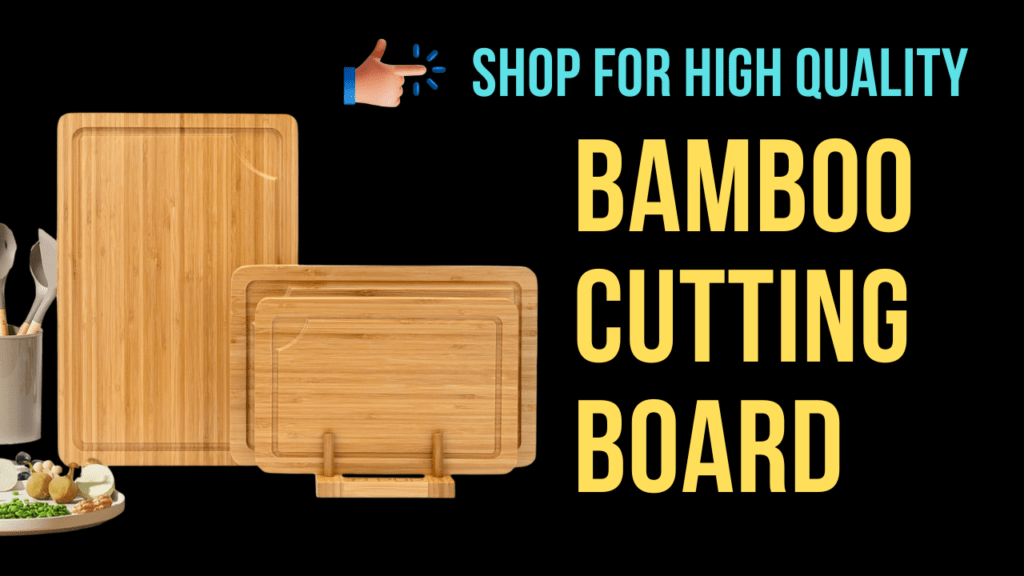
Introduction
Bamboo cutting boards have become one of the most popular choices for home cooks and professional chefs alike. Known for their eco-friendliness, durability, and sleek appearance, bamboo boards are often marketed as the perfect kitchen companion. But are they really the best choice for your knives and long-term cooking needs?
In this article, we’ll explore everything about bamboo cutting boards—their benefits, limitations, maintenance tips, and expert opinions—so you can make an informed decision for your kitchen.
What is a Bamboo Cutting Board?
Unlike hardwood boards made from maple or walnut, bamboo boards are created from thin strips of bamboo grass that are glued together under high pressure. This process gives them a dense and hard surface that looks beautiful and resists water absorption.
Benefits of Bamboo Cutting Boards
1. Eco-Friendly and Sustainable
- Bamboo is a fast-growing, renewable resource that reaches maturity in only 3 to 6 years, unlike hardwood trees that take decades to mature.
- It is self-regenerating, requiring fewer chemicals and less water to grow.
- FSC-certified bamboo boards ensure responsible sourcing.
2. Affordable and Durable
- Bamboo boards are typically cheaper than hardwood boards while still offering long-lasting performance.
- Their density provides resistance against cracking, warping, or absorbing too much moisture.
3. Hygienic and Naturally Antimicrobial
- Bamboo has natural antimicrobial properties that help reduce bacteria such as Salmonella.
- Its tight grain resists deep knife scars, which means fewer spaces for germs to hide.
4. Low Maintenance
- Less porous than traditional wood, bamboo does not absorb water easily.
- With proper cleaning and occasional oiling, a bamboo cutting board can last for years.
5. Modern and Attractive Appearance
- Bamboo has a light, elegant finish with a smooth, uniform grain.
- It resists staining from foods like tomatoes, garlic, or meat, keeping its fresh look longer.

VISIT HERE TO SHOP BAMBOO CUTTING BOARD AT BEST DISCOUNTED PRICE
Drawbacks of Bamboo Cutting Boards
While bamboo boards have many advantages, they are not without limitations.
1. Hard on Knives
- According to knife experts and Serious Eats, bamboo’s hardness and silica content can quickly dull or even chip knife edges.
- For expensive knives, hardwoods like maple, walnut, or Japanese hinoki are gentler alternatives.
2. Potential Glue Issues
Because bamboo boards are laminated, low-quality boards may use formaldehyde-based glues, which are not food-safe.
Always choose bamboo cutting boards without formaldehyde from trusted brands.
3. Not Dishwasher-Safe
- Heat and water can make the board crack or splinter.
- Bamboo boards must be hand-washed and air-dried.
How to Clean and Care for a Bamboo Cutting Board
Proper care is essential for extending the lifespan of your bamboo cutting board. Here’s a step-by-step guide based on expert recommendations:
Cleaning Routine
- Wash with warm water and mild dish soap immediately after use.
- Avoid soaking the board or putting it in the dishwasher.
- Dry thoroughly with a towel, then stand upright or place on a rack to air dry.
Disinfecting
- Use white vinegar for natural disinfection.
- For stubborn stains or odors, scrub with lemon and coarse salt.
- For stronger cleaning, a diluted bleach solution (1 tsp bleach in 2 quarts water) may be used.
Oiling & Conditioning
- Apply food-grade mineral oil once a month (or more in dry climates).
- Soak the board overnight, then wipe off the extra water.
- Avoid cooking oils like olive or vegetable oil—they can turn rancid.
Bamboo Cutting Board vs. Other Materials
| Feature | Bamboo Cutting Board | Hardwood (Maple/Walnut) | Plastic Cutting Board |
| Sustainability | Highly eco-friendly | Less sustainable | Not eco-friendly |
| Knife-Friendliness | Can dull knives faster | Gentle on knives | Easy on knives but scars easily |
| Hygiene | Naturally antimicrobial | Hygienic with oiling | Holds bacteria in grooves |
| Durability | Strong, resists warping | Very durable | Can warp/melt with heat |
| Maintenance | Needs oiling, hand wash | Needs oiling, hand wash | Dishwasher-safe (but less durable) |
FAQs about Bamboo Cutting Boards
Q1. Are bamboo cutting boards safe for meat?
Yes, bamboo boards are safe for meat if disinfected properly. Use vinegar or diluted bleach solution after cutting raw meat to avoid cross-contamination.
Q2. Do bamboo cutting boards dull knives?
Yes, bamboo’s hardness and silica content can dull knives faster than softer woods like maple or walnut. If you own expensive knives, consider hardwood boards.
Q3. How often should I oil my bamboo cutting board?
At least once a month. If your board looks dry, cracked, or rough, it’s time to re-oil.
Q4. Can bamboo cutting boards go in the dishwasher?
No. Dishwashers expose boards to high heat and prolonged water, which leads to warping and cracking. Always hand-wash.
Q5. Are bamboo cutting boards better than plastic?
Bamboo is more eco-friendly, durable, and hygienic compared to plastic. However, plastic is gentler on knives and dishwasher-safe.
Final Thoughts
A bamboo cutting board is a great choice if you want an eco-friendly, affordable, and clean kitchen tool. With good care—like regular cleaning, oiling, and disinfecting—it can last a long time. But if keeping your knives very sharp is most important, hardwood boards such as maple or walnut might be better.
Overall, bamboo cutting boards offer a good mix of sustainability, style, and usefulness, making them a smart option for many kitchens.
Disclaimer
As an Amazon Associate, I earn from qualifying purchases. This means I may receive a commission if you purchase through links on this site, at no extra cost to you.

